Abstract
1. The pharmacological profile of valsartan, (S)-N-valeryl-N-([2'-(1H-tetrazol-5-yl)biphenyl-4-yl]-methyl)-vali ne, a potent, highly selective, and orally active antagonist at the angiotensin II (AII) AT1-receptor, was studied in vitro and in vivo. 2. Valsartan competed with [125I]-AII at its specific binding sites in rat aortic smooth muscle cell membranes (AT1-receptor subtype) with a Ki of 2.38 nM, but was about 30,000 times less active in human myometrial membranes (AT2-receptor subtype). 3. In rabbit aortic rings incubated for 5 min with valsartan, at concentrations of 2, 20 and 200 nM, the concentration-response curve of AII was displaced to the right and the maximum response was reduced by 33%, 36% and 40%, respectively. Prolongation of the incubation time with valsartan to 1 h or 3 h, further reduced the maximum response by 48% or 59% (after 20 nM) and by 59% or 60% (after 200 nM) respectively. After 3 h incubation an apparent pKb value of 9.26 was calculated. Contractions induced by noradrenaline, 5-hydroxytryptamine, or potassium chloride were not affected by valsartan. No agonistic effects were observed in the rabbit aorta at concentrations of valsartan up to 2 microM. 4. In bovine adrenal glomerulosa, valsartan inhibited AII-stimulated aldosterone release without affecting the maximum response (pA2 8.4). 5. In the pithed rat, oral administration of valsartan (10 mg kg-1) shifted the AII-induced pressor response curves to the right, without affecting responses induced by the electrical stimulation of the sympathetic outflow or by noradrenaline. Animals treated with valsartan 24 h before pithing also showed significant inhibition of the response to AII. 6. In conscious, two-kidney, one-clip renal hypertensive rats (2K1C), valsartan decreased blood pressure in a dose-dependent manner after single i.v. or oral administration. The respective ED30 values were 0.06 mg kg-1 (i.v.) and 1.4 mg kg-1 (p.o.). The antihypertensive effect lasted for at least 24 h after either route of administration. After repeated oral administration for 4 days (3 and 10 mg kg-1 daily), in 2K1C renal hypertensive rats, systolic blood pressure was consistently decreased, but heart rate was not significantly affected. 7. In conscious, normotensive, sodium-depleted marmosets, valsartan decreased mean arterial pressure, measured by telemetry, after oral doses of 1-30 mg kg-1. The hypotensive effect persisted up to 12 h after 3 and 10 mg kg-1 and up to 24 h after 30 mg kg-1.(ABSTRACT TRUNCATED AT 400 WORDS)
Full text
PDF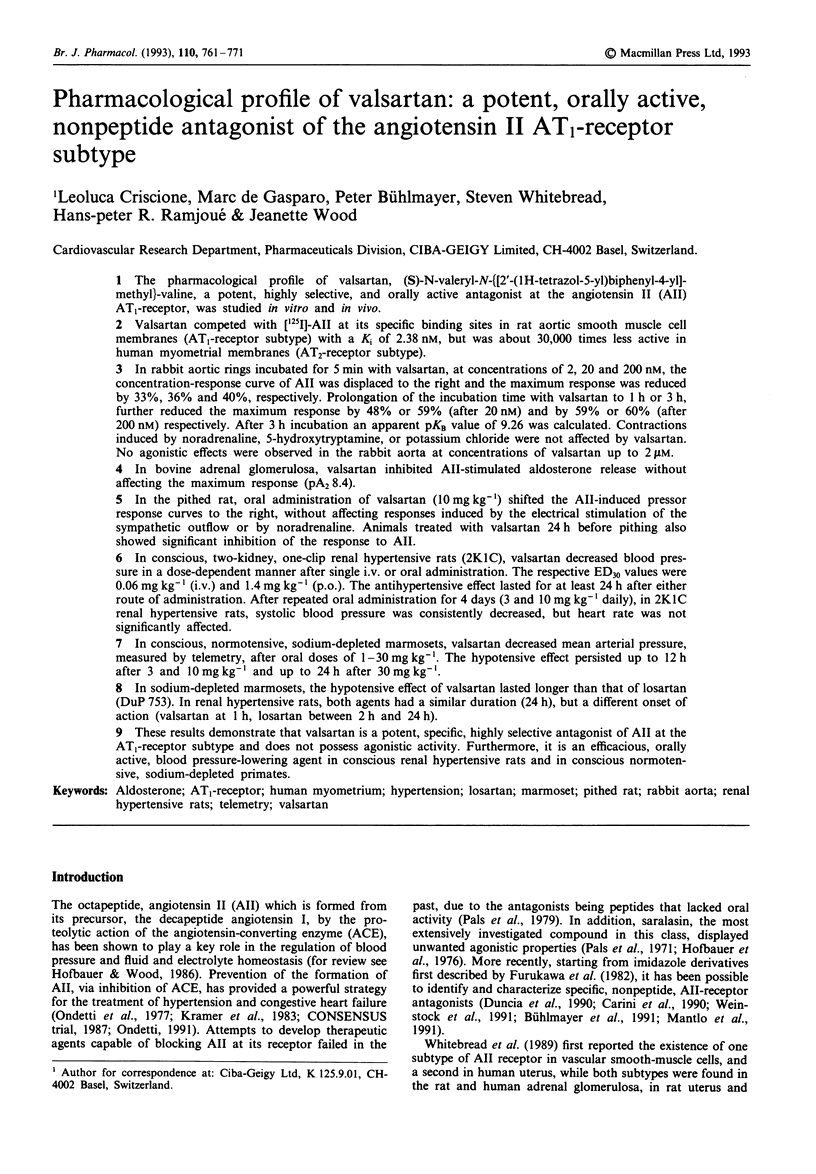
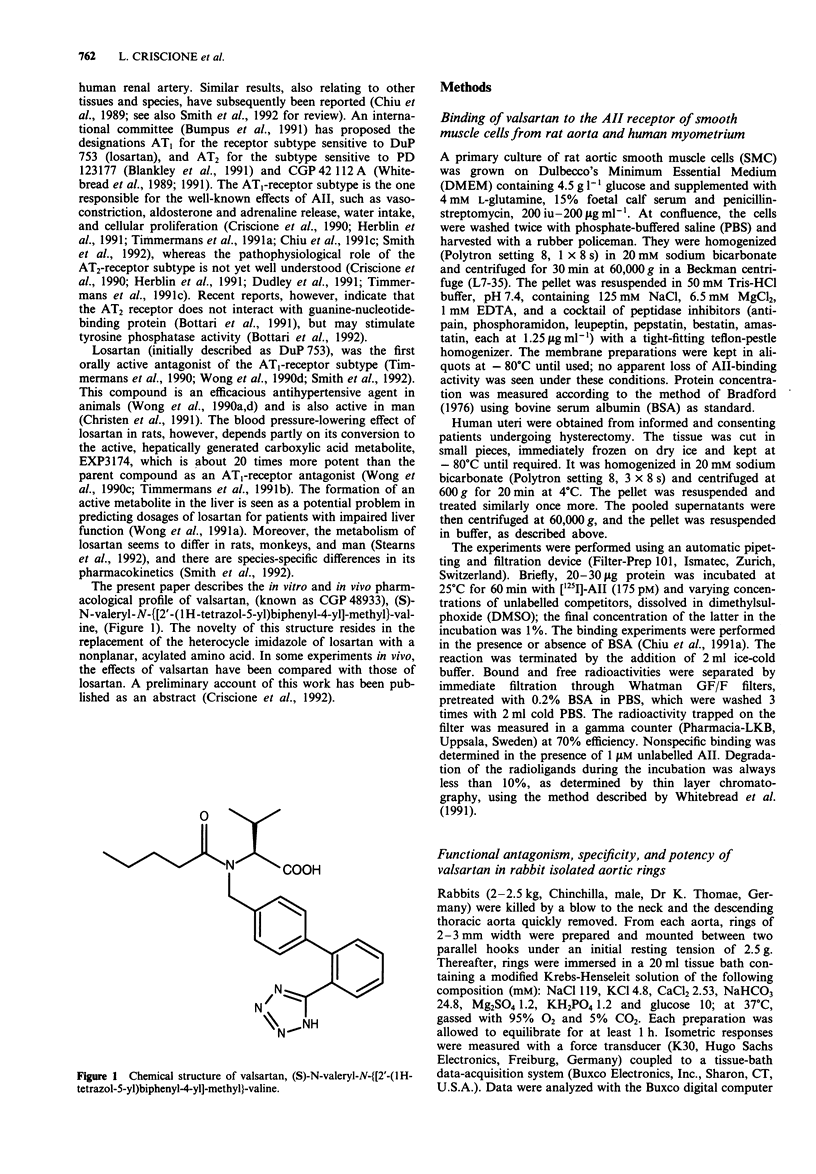
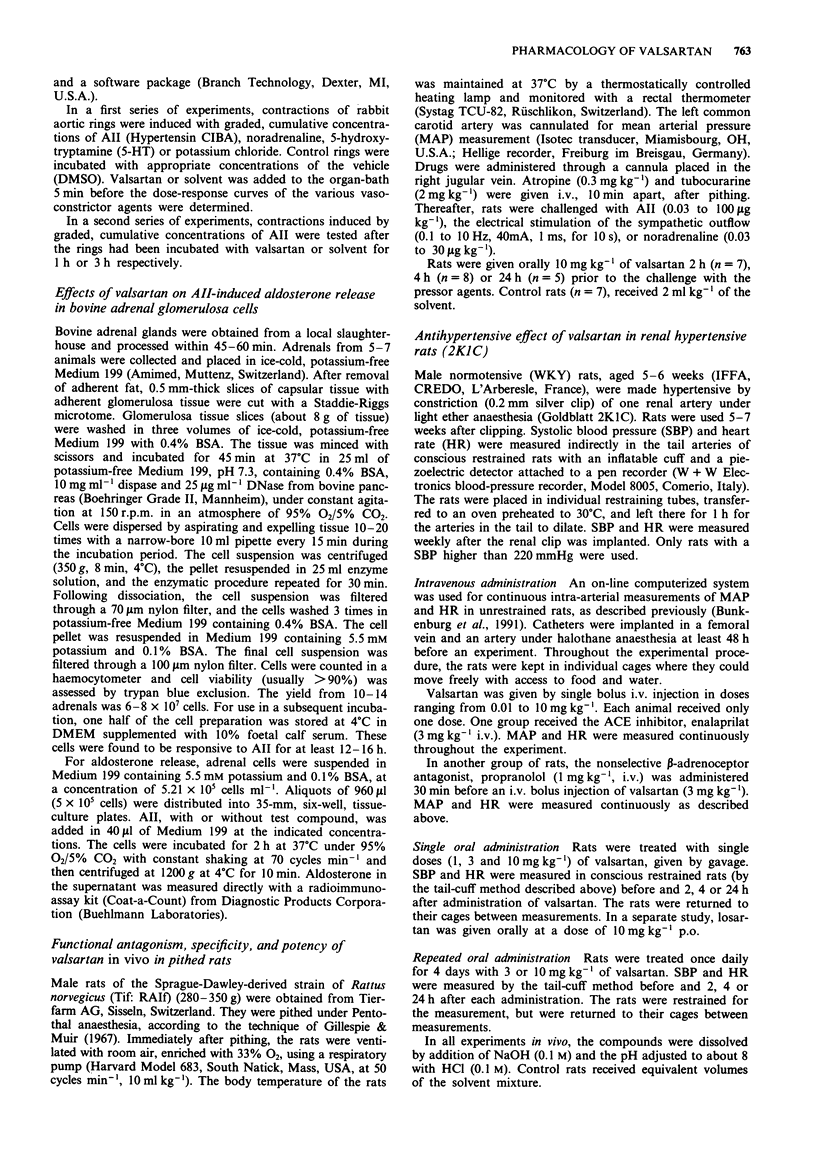
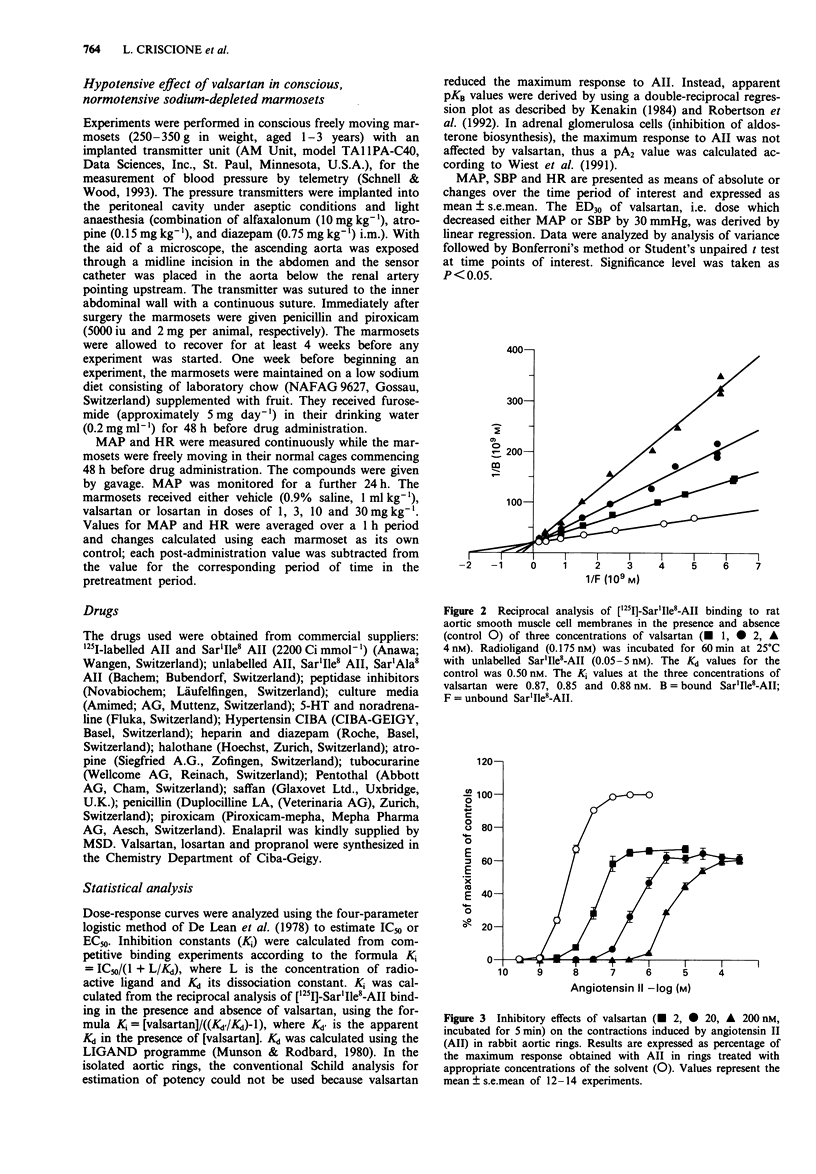
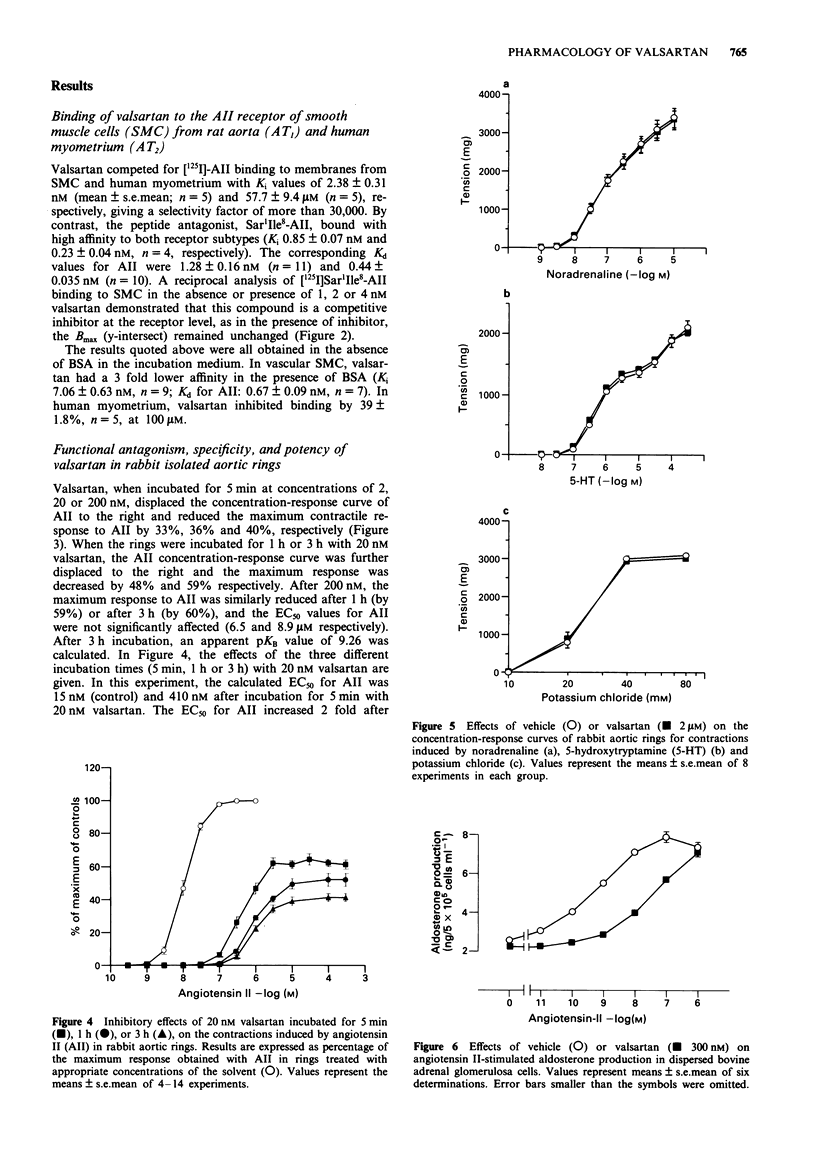
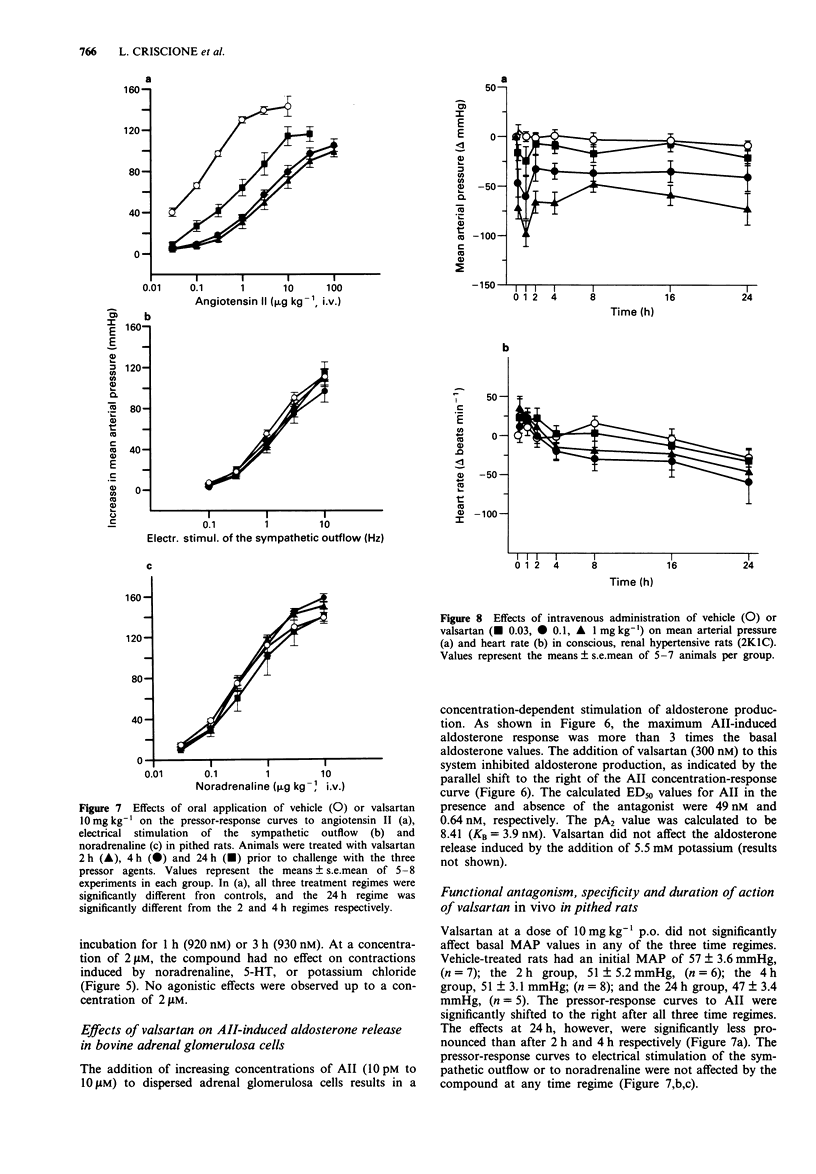
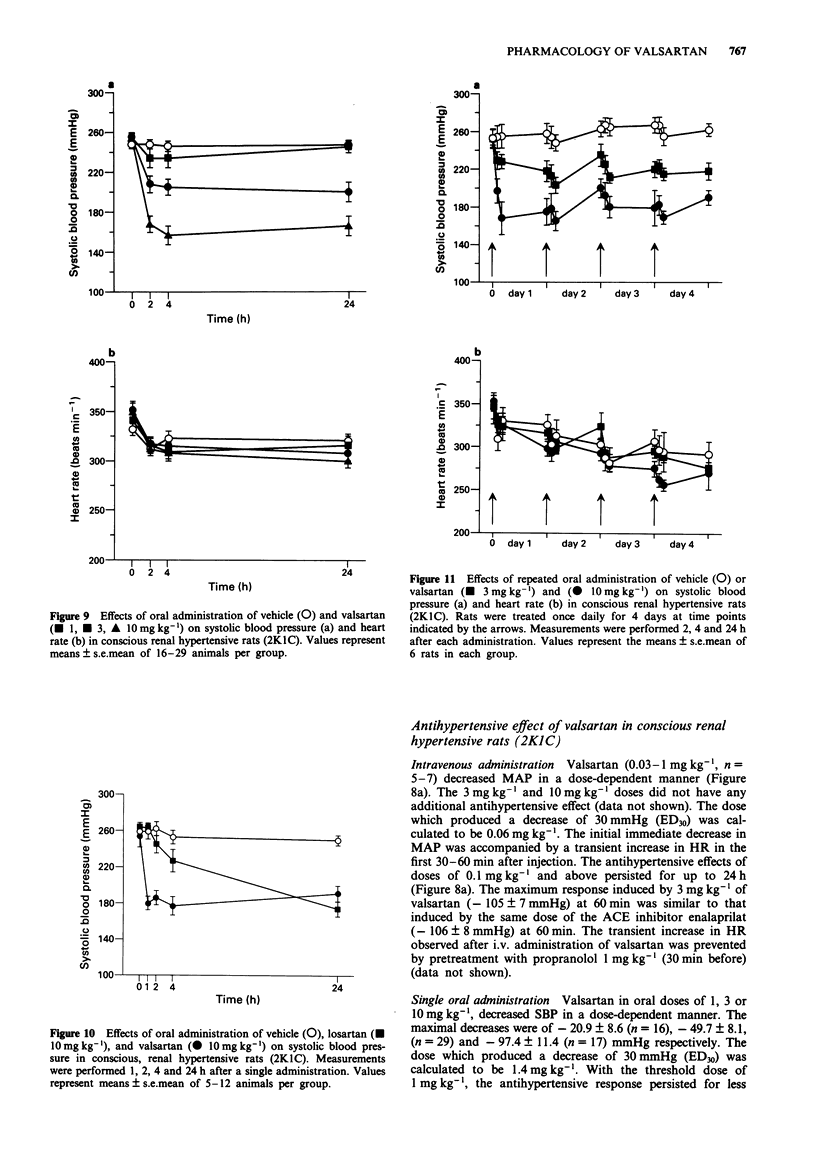
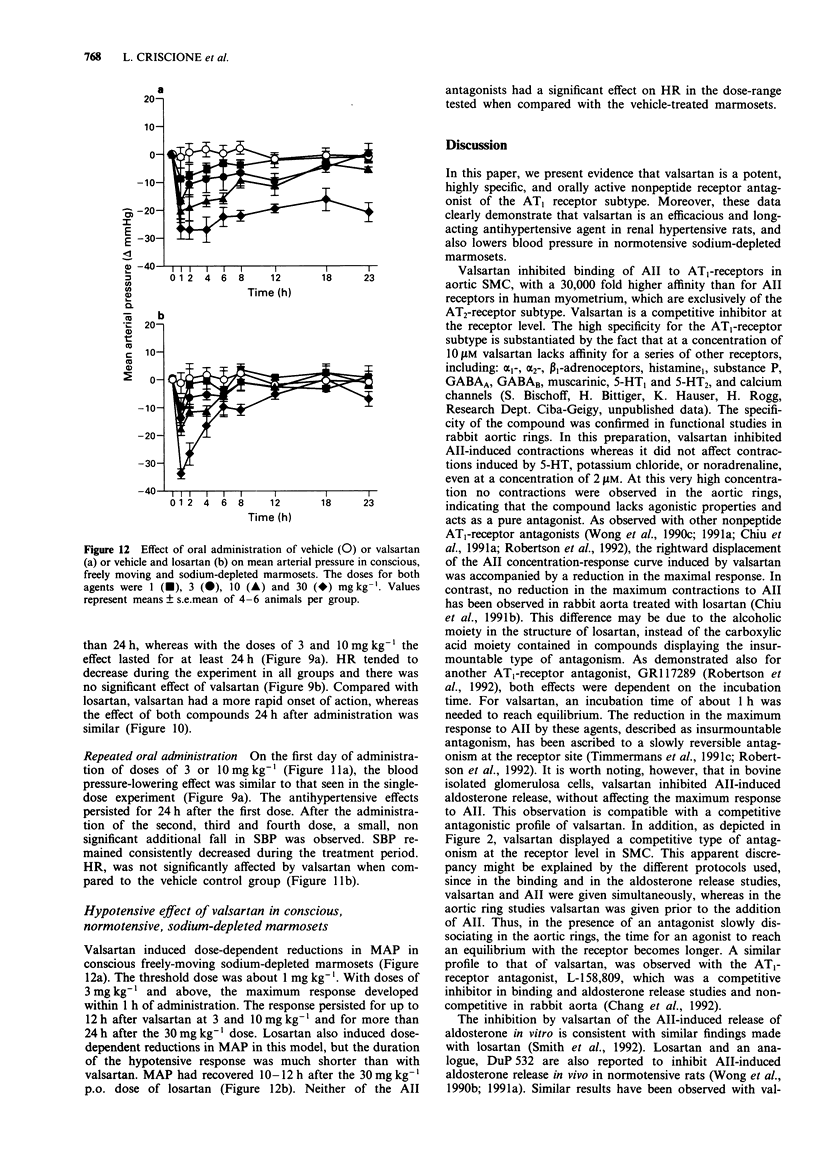
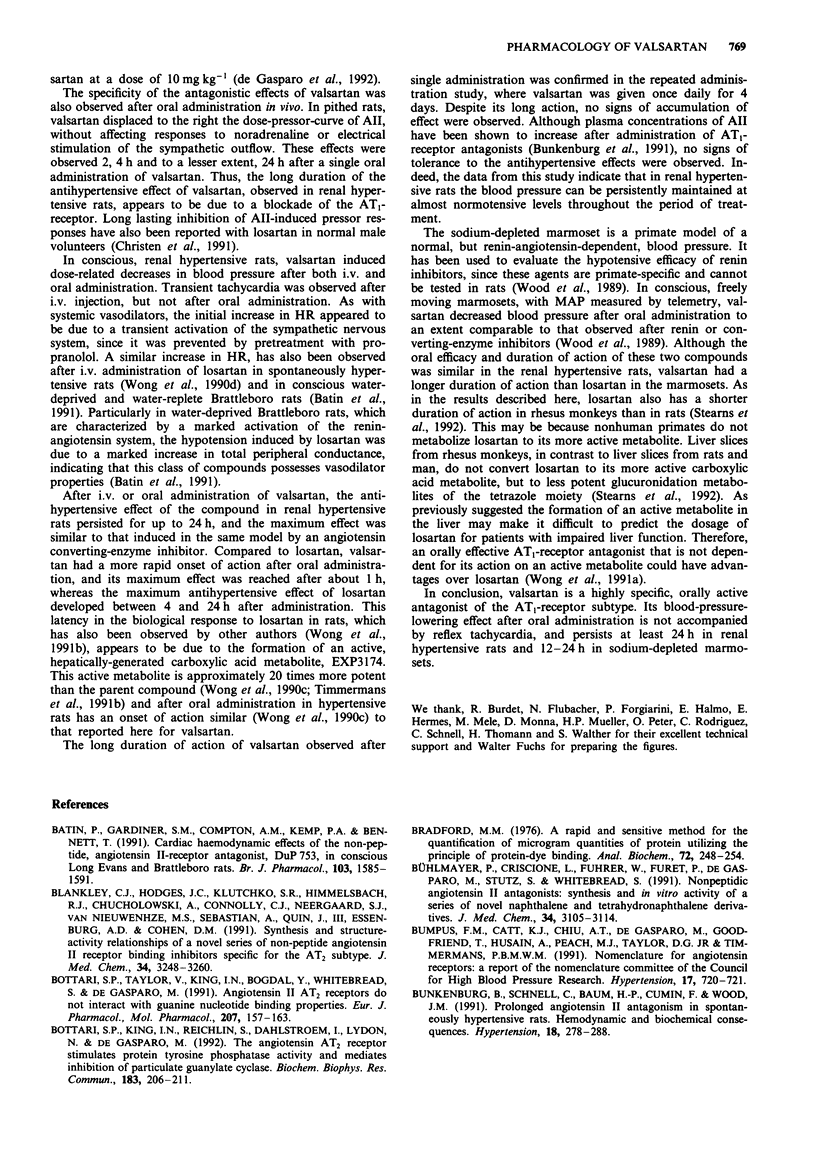
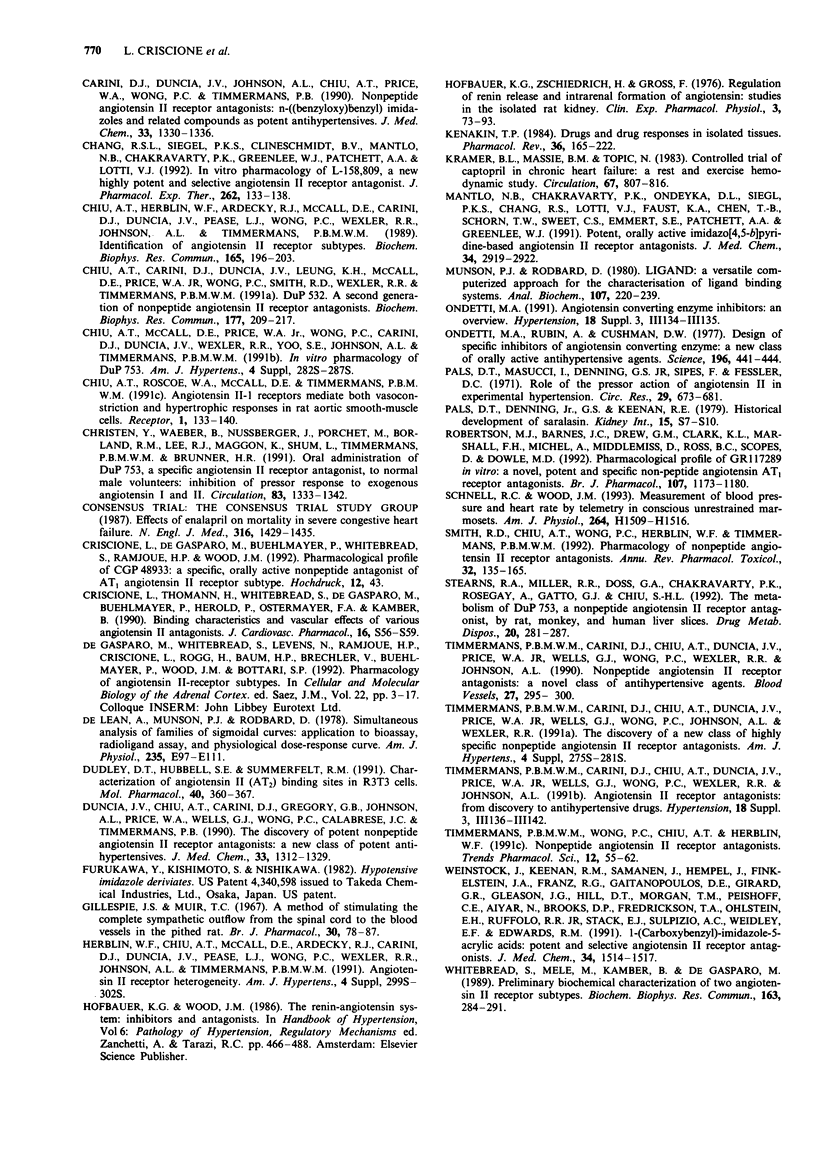
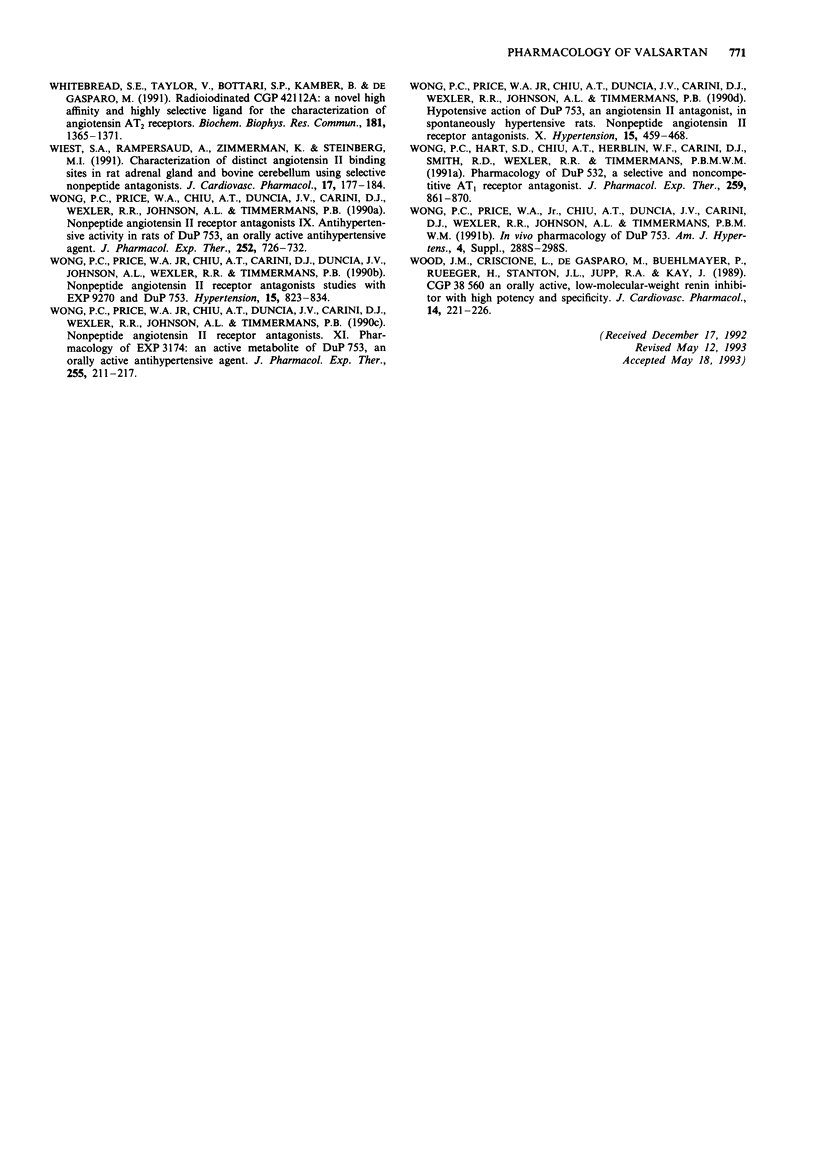
Selected References
These references are in PubMed. This may not be the complete list of references from this article.
- Batin P., Gardiner S. M., Compton A. M., Kemp P. A., Bennett T. Cardiac haemodynamic effects of the non-peptide, angiotensin II-receptor antagonist, DuP 753, in conscious Long Evans and Brattleboro rats. Br J Pharmacol. 1991 Jun;103(2):1585–1591. doi: 10.1111/j.1476-5381.1991.tb09831.x. [DOI] [PMC free article] [PubMed] [Google Scholar]
- Blankley C. J., Hodges J. C., Klutchko S. R., Himmelsbach R. J., Chucholowski A., Connolly C. J., Neergaard S. J., Van Nieuwenhze M. S., Sebastian A., Quin J., 3rd Synthesis and structure-activity relationships of a novel series of non-peptide angiotensin II receptor binding inhibitors specific for the AT2 subtype. J Med Chem. 1991 Nov;34(11):3248–3260. doi: 10.1021/jm00115a014. [DOI] [PubMed] [Google Scholar]
- Bottari S. P., King I. N., Reichlin S., Dahlstroem I., Lydon N., de Gasparo M. The angiotensin AT2 receptor stimulates protein tyrosine phosphatase activity and mediates inhibition of particulate guanylate cyclase. Biochem Biophys Res Commun. 1992 Feb 28;183(1):206–211. doi: 10.1016/0006-291x(92)91629-5. [DOI] [PubMed] [Google Scholar]
- Bottari S. P., Taylor V., King I. N., Bogdal Y., Whitebread S., de Gasparo M. Angiotensin II AT2 receptors do not interact with guanine nucleotide binding proteins. Eur J Pharmacol. 1991 Jun 19;207(2):157–163. doi: 10.1016/0922-4106(91)90091-u. [DOI] [PubMed] [Google Scholar]
- Bradford M. M. A rapid and sensitive method for the quantitation of microgram quantities of protein utilizing the principle of protein-dye binding. Anal Biochem. 1976 May 7;72:248–254. doi: 10.1016/0003-2697(76)90527-3. [DOI] [PubMed] [Google Scholar]
- Bumpus F. M., Catt K. J., Chiu A. T., DeGasparo M., Goodfriend T., Husain A., Peach M. J., Taylor D. G., Jr, Timmermans P. B. Nomenclature for angiotensin receptors. A report of the Nomenclature Committee of the Council for High Blood Pressure Research. Hypertension. 1991 May;17(5):720–721. doi: 10.1161/01.hyp.17.5.720. [DOI] [PubMed] [Google Scholar]
- Bunkenburg B., Schnell C., Baum H. P., Cumin F., Wood J. M. Prolonged angiotensin II antagonism in spontaneously hypertensive rats. Hemodynamic and biochemical consequences. Hypertension. 1991 Sep;18(3):278–288. doi: 10.1161/01.hyp.18.3.278. [DOI] [PubMed] [Google Scholar]
- Bühlmayer P., Criscione L., Fuhrer W., Furet P., de Gasparo M., Stutz S., Whitebread S. Nonpeptidic angiotensin II antagonists: synthesis and in vitro activity of a series of novel naphthalene and tetrahydronaphthalene derivatives. J Med Chem. 1991 Oct;34(10):3105–3114. doi: 10.1021/jm00114a021. [DOI] [PubMed] [Google Scholar]
- Carini D. J., Duncia J. V., Johnson A. L., Chiu A. T., Price W. A., Wong P. C., Timmermans P. B. Nonpeptide angiotensin II receptor antagonists: N-[(benzyloxy)benzyl]imidazoles and related compounds as potent antihypertensives. J Med Chem. 1990 May;33(5):1330–1336. doi: 10.1021/jm00167a008. [DOI] [PubMed] [Google Scholar]
- Chang R. S., Siegl P. K., Clineschmidt B. V., Mantlo N. B., Chakravarty P. K., Greenlee W. J., Patchett A. A., Lotti V. J. In vitro pharmacology of L-158,809, a new highly potent and selective angiotensin II receptor antagonist. J Pharmacol Exp Ther. 1992 Jul;262(1):133–138. [PubMed] [Google Scholar]
- Chiu A. T., Carini D. J., Duncia J. V., Leung K. H., McCall D. E., Price W. A., Jr, Wong P. C., Smith R. D., Wexler R. R., Timmermans P. B. DuP 532: a second generation of nonpeptide angiotensin II receptor antagonists. Biochem Biophys Res Commun. 1991 May 31;177(1):209–217. doi: 10.1016/0006-291x(91)91969-j. [DOI] [PubMed] [Google Scholar]
- Chiu A. T., Herblin W. F., McCall D. E., Ardecky R. J., Carini D. J., Duncia J. V., Pease L. J., Wong P. C., Wexler R. R., Johnson A. L. Identification of angiotensin II receptor subtypes. Biochem Biophys Res Commun. 1989 Nov 30;165(1):196–203. doi: 10.1016/0006-291x(89)91054-1. [DOI] [PubMed] [Google Scholar]
- Chiu A. T., McCall D. E., Price W. A., Jr, Wong P. C., Carini D. J., Duncia J. V., Wexler R. R., Yoo S. E., Johnson A. L., Timmermans P. B. In vitro pharmacology of DuP 753. Am J Hypertens. 1991 Apr;4(4 Pt 2):282S–287S. doi: 10.1093/ajh/4.4.282s. [DOI] [PubMed] [Google Scholar]
- Chiu A. T., Roscoe W. A., McCall D. E., Timmermans P. B. Angiotensin II-1 receptors mediate both vasoconstrictor and hypertrophic responses in rat aortic smooth muscle cells. Receptor. 1991;1(3):133–140. [PubMed] [Google Scholar]
- Christen Y., Waeber B., Nussberger J., Porchet M., Borland R. M., Lee R. J., Maggon K., Shum L., Timmermans P. B., Brunner H. R. Oral administration of DuP 753, a specific angiotensin II receptor antagonist, to normal male volunteers. Inhibition of pressor response to exogenous angiotensin I and II. Circulation. 1991 Apr;83(4):1333–1342. doi: 10.1161/01.cir.83.4.1333. [DOI] [PubMed] [Google Scholar]
- Criscione L., Thomann H., Whitebread S., de Gasparo M., Bühlmayer P., Herold P., Ostermayer F., Kamber B. Binding characteristics and vascular effects of various angiotensin II antagonists. J Cardiovasc Pharmacol. 1990;16 (Suppl 4):S56–S59. doi: 10.1097/00005344-199016004-00012. [DOI] [PubMed] [Google Scholar]
- Dudley D. T., Hubbell S. E., Summerfelt R. M. Characterization of angiotensin II (AT2) binding sites in R3T3 cells. Mol Pharmacol. 1991 Sep;40(3):360–367. [PubMed] [Google Scholar]
- Duncia J. V., Chiu A. T., Carini D. J., Gregory G. B., Johnson A. L., Price W. A., Wells G. J., Wong P. C., Calabrese J. C., Timmermans P. B. The discovery of potent nonpeptide angiotensin II receptor antagonists: a new class of potent antihypertensives. J Med Chem. 1990 May;33(5):1312–1329. doi: 10.1021/jm00167a007. [DOI] [PubMed] [Google Scholar]
- Gillespie J. S., Muir T. C. A method of stimulating the complete sympathetic outflow from the spinal cord to blood vessels in the pithed rat. Br J Pharmacol Chemother. 1967 May;30(1):78–87. doi: 10.1111/j.1476-5381.1967.tb02114.x. [DOI] [PMC free article] [PubMed] [Google Scholar]
- Herblin W. F., Chiu A. T., McCall D. E., Ardecky R. J., Carini D. J., Duncia J. V., Pease L. J., Wong P. C., Wexler R. R., Johnson A. L. Angiotensin II receptor heterogeneity. Am J Hypertens. 1991 Apr;4(4 Pt 2):299S–302S. doi: 10.1093/ajh/4.4.299s. [DOI] [PubMed] [Google Scholar]
- Hofbauer K. G., Zschiedrich H., Gross F. Regulation of renin release and intrarenal formation of angiotensin. Studies in the isolated perfused rat kidney. Clin Exp Pharmacol Physiol. 1976 Jan-Feb;3(1):73–93. doi: 10.1111/j.1440-1681.1976.tb00593.x. [DOI] [PubMed] [Google Scholar]
- Kenakin T. P. The classification of drugs and drug receptors in isolated tissues. Pharmacol Rev. 1984 Sep;36(3):165–222. [PubMed] [Google Scholar]
- Kramer B. L., Massie B. M., Topic N. Controlled trial of captopril in chronic heart failure: a rest and exercise hemodynamic study. Circulation. 1983 Apr;67(4):807–816. doi: 10.1161/01.cir.67.4.807. [DOI] [PubMed] [Google Scholar]
- Mantlo N. B., Chakravarty P. K., Ondeyka D. L., Siegl P. K., Chang R. S., Lotti V. J., Faust K. A., Chen T. B., Schorn T. W., Sweet C. S. Potent, orally active imidazo[4,5-b]pyridine-based angiotensin II receptor antagonists. J Med Chem. 1991 Sep;34(9):2919–2922. doi: 10.1021/jm00113a035. [DOI] [PubMed] [Google Scholar]
- Munson P. J., Rodbard D. Ligand: a versatile computerized approach for characterization of ligand-binding systems. Anal Biochem. 1980 Sep 1;107(1):220–239. doi: 10.1016/0003-2697(80)90515-1. [DOI] [PubMed] [Google Scholar]
- Ondetti M. A. Angiotensin converting enzyme inhibitors. An overview. Hypertension. 1991 Nov;18(5 Suppl):III134–III135. doi: 10.1161/01.hyp.18.5_suppl.iii134. [DOI] [PubMed] [Google Scholar]
- Ondetti M. A., Rubin B., Cushman D. W. Design of specific inhibitors of angiotensin-converting enzyme: new class of orally active antihypertensive agents. Science. 1977 Apr 22;196(4288):441–444. doi: 10.1126/science.191908. [DOI] [PubMed] [Google Scholar]
- Pals D. T., Masucci F. D., Denning G. S., Jr, Sipos F., Fessler D. C. Role of the pressor action of angiotensin II in experimental hypertension. Circ Res. 1971 Dec;29(6):673–681. doi: 10.1161/01.res.29.6.673. [DOI] [PubMed] [Google Scholar]
- Robertson M. J., Barnes J. C., Drew G. M., Clark K. L., Marshall F. H., Michel A., Middlemiss D., Ross B. C., Scopes D., Dowle M. D. Pharmacological profile of GR117289 in vitro: a novel, potent and specific non-peptide angiotensin AT1 receptor antagonist. Br J Pharmacol. 1992 Dec;107(4):1173–1180. doi: 10.1111/j.1476-5381.1992.tb13425.x. [DOI] [PMC free article] [PubMed] [Google Scholar]
- Schnell C. R., Wood J. M. Measurement of blood pressure and heart rate by telemetry in conscious, unrestrained marmosets. Am J Physiol. 1993 May;264(5 Pt 2):H1509–H1516. doi: 10.1152/ajpheart.1993.264.5.H1509. [DOI] [PubMed] [Google Scholar]
- Smith R. D., Chiu A. T., Wong P. C., Herblin W. F., Timmermans P. B. Pharmacology of nonpeptide angiotensin II receptor antagonists. Annu Rev Pharmacol Toxicol. 1992;32:135–165. doi: 10.1146/annurev.pa.32.040192.001031. [DOI] [PubMed] [Google Scholar]
- Stearns R. A., Miller R. R., Doss G. A., Chakravarty P. K., Rosegay A., Gatto G. J., Chiu S. H. The metabolism of DuP 753, a nonpeptide angiotensin II receptor antagonist, by rat, monkey, and human liver slices. Drug Metab Dispos. 1992 Mar-Apr;20(2):281–287. [PubMed] [Google Scholar]
- Timmermans P. B., Carini D. J., Chiu A. T., Duncia J. V., Price W. A., Jr, Wells G. J., Wong P. C., Johnson A. L., Wexler R. R. The discovery of a new class of highly specific nonpeptide angiotensin II receptor antagonists. Am J Hypertens. 1991 Apr;4(4 Pt 2):275S–281S. doi: 10.1093/ajh/4.4.275s. [DOI] [PubMed] [Google Scholar]
- Timmermans P. B., Carini D. J., Chiu A. T., Duncia J. V., Price W. A., Jr, Wells G. J., Wong P. C., Wexler R. R., Johnson A. L. Angiotensin II receptor antagonists. From discovery to antihypertensive drugs. Hypertension. 1991 Nov;18(5 Suppl):III136–III142. doi: 10.1161/01.hyp.18.5_suppl.iii136. [DOI] [PubMed] [Google Scholar]
- Timmermans P. B., Carini D. J., Chiu A. T., Duncia J. V., Price W. A., Jr, Wells G. J., Wong P. C., Wexler R. R., Johnson A. L. Nonpeptide angiotensin II receptor antagonists: a novel class of antihypertensive agents. Blood Vessels. 1990;27(2-5):295–300. doi: 10.1159/000158821. [DOI] [PubMed] [Google Scholar]
- Timmermans P. B., Wong P. C., Chiu A. T., Herblin W. F. Nonpeptide angiotensin II receptor antagonists. Trends Pharmacol Sci. 1991 Feb;12(2):55–62. doi: 10.1016/0165-6147(91)90498-h. [DOI] [PubMed] [Google Scholar]
- Weinstock J., Keenan R. M., Samanen J., Hempel J., Finkelstein J. A., Franz R. G., Gaitanopoulos D. E., Girard G. R., Gleason J. G., Hill D. T. 1-(carboxybenzyl)imidazole-5-acrylic acids: potent and selective angiotensin II receptor antagonists. J Med Chem. 1991 Apr;34(4):1514–1517. doi: 10.1021/jm00108a043. [DOI] [PubMed] [Google Scholar]
- Whitebread S. E., Taylor V., Bottari S. P., Kamber B., de Gasparo M. Radioiodinated CGP 42112A: a novel high affinity and highly selective ligand for the characterization of angiotensin AT2 receptors. Biochem Biophys Res Commun. 1991 Dec 31;181(3):1365–1371. doi: 10.1016/0006-291x(91)92089-3. [DOI] [PubMed] [Google Scholar]
- Whitebread S., Mele M., Kamber B., de Gasparo M. Preliminary biochemical characterization of two angiotensin II receptor subtypes. Biochem Biophys Res Commun. 1989 Aug 30;163(1):284–291. doi: 10.1016/0006-291x(89)92133-5. [DOI] [PubMed] [Google Scholar]
- Wiest S. A., Rampersaud A., Zimmerman K., Steinberg M. I. Characterization of distinct angiotensin II binding sites in rat adrenal gland and bovine cerebellum using selective nonpeptide antagonists. J Cardiovasc Pharmacol. 1991 Feb;17(2):177–184. doi: 10.1097/00005344-199102000-00001. [DOI] [PubMed] [Google Scholar]
- Wong P. C., Hart S. D., Chiu A. T., Herblin W. F., Carini D. J., Smith R. D., Wexler R. R., Timmermans P. B. Pharmacology of DuP 532, a selective and noncompetitive AT1 receptor antagonist. J Pharmacol Exp Ther. 1991 Nov;259(2):861–870. [PubMed] [Google Scholar]
- Wong P. C., Price W. A., Chiu A. T., Duncia J. V., Carini D. J., Wexler R. R., Johnson A. L., Timmermans P. B. Nonpeptide angiotensin II receptor antagonists. IX. Antihypertensive activity in rats of DuP 753, an orally active antihypertensive agent. J Pharmacol Exp Ther. 1990 Feb;252(2):726–732. [PubMed] [Google Scholar]
- Wong P. C., Price W. A., Jr, Chiu A. T., Carini D. J., Duncia J. V., Johnson A. L., Wexler R. R., Timmermans P. B. Nonpeptide angiotensin II receptor antagonists. Studies with EXP9270 and DuP 753. Hypertension. 1990 Jun;15(6 Pt 2):823–834. doi: 10.1161/01.hyp.15.6.823. [DOI] [PubMed] [Google Scholar]
- Wong P. C., Price W. A., Jr, Chiu A. T., Duncia J. V., Carini D. J., Wexler R. R., Johnson A. L., Timmermans P. B. In vivo pharmacology of DuP 753. Am J Hypertens. 1991 Apr;4(4 Pt 2):288S–298S. doi: 10.1093/ajh/4.4.288s. [DOI] [PubMed] [Google Scholar]
- Wong P. C., Price W. A., Jr, Chiu A. T., Duncia J. V., Carini D. J., Wexler R. R., Johnson A. L., Timmermans P. B. Nonpeptide angiotensin II receptor antagonists. XI. Pharmacology of EXP3174: an active metabolite of DuP 753, an orally active antihypertensive agent. J Pharmacol Exp Ther. 1990 Oct;255(1):211–217. [PubMed] [Google Scholar]
- Wood J. M., Criscione L., de Gasparo M., Bühlmayer P., Rüeger H., Stanton J. L., Jupp R. A., Kay J. CGP 38 560: orally active, low-molecular-weight renin inhibitor with high potency and specificity. J Cardiovasc Pharmacol. 1989 Aug;14(2):221–226. [PubMed] [Google Scholar]


